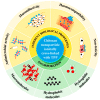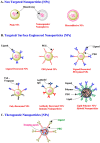Polymer-Based Nanomaterials and Applications for Vaccines and Drugs
- PMID: 30966075
- PMCID: PMC6415012
- DOI: 10.3390/polym10010031
Polymer-Based Nanomaterials and Applications for Vaccines and Drugs
Abstract
Nanotechnology plays a significant role in drug development. As carriers, polymeric nanoparticles can deliver vaccine antigens, proteins, and drugs to the desired site of action. Polymeric nanoparticles with lower cytotoxicity can protect the delivered antigens or drugs from degradation under unfavorable conditions via a mucosal administration route; further, the uptake of nanoparticles by antigen-presenting cells can increase and induce potent immune responses. Additionally, nanomaterials are widely used in vaccine delivery systems because nanomaterials can make the vaccine antigen long-acting. This review focuses on some biodegradable polymer materials such as natural polymeric nanomaterials, chemically synthesized polymer materials, and biosynthesized polymeric materials, and points out the advantages and the direction of research on degradable polymeric materials. The application and future perspectives of polymeric materials as delivery carriers and vaccine adjuvants in the field of drugs and vaccines are presented. With the increase of knowledge and fundamental understandings of polymer-based nanomaterials, means of integrating some other attractive properties, such as slow release, target delivery, and alternative administration methods and delivery pathways are feasible. Polymer-based nanomaterials have great potential for the development of novel vaccines and drug systems for certain needs, including single-dose and needle-free deliveries of vaccine antigens and drugs in the future.
Keywords: delivery carriers; drugs; nanoparticles; polymer-based nanomaterials; vaccine adjuvants; vaccines.
Conflict of interest statement
The authors declare no conflicts of interest in this work.
Figures



Similar articles
-
An overview of biodegradable nanomaterials and applications in vaccines.Vaccine. 2020 Jan 29;38(5):1096-1104. doi: 10.1016/j.vaccine.2019.11.031. Epub 2019 Dec 6. Vaccine. 2020. PMID: 31813649 Review.
-
Adjuvants and delivery systems based on polymeric nanoparticles for mucosal vaccines.Int J Pharm. 2019 Dec 15;572:118731. doi: 10.1016/j.ijpharm.2019.118731. Epub 2019 Oct 24. Int J Pharm. 2019. PMID: 31669213 Review.
-
[Development of polymeric nanoparticles-based vaccine].Nihon Rinsho. 2006 Feb;64(2):279-85. Nihon Rinsho. 2006. PMID: 16454182 Review. Japanese.
-
Recent advances in mucosal delivery of vaccines: role of mucoadhesive/biodegradable polymeric carriers.Expert Opin Ther Pat. 2010 May;20(5):661-79. doi: 10.1517/13543771003730425. Expert Opin Ther Pat. 2010. PMID: 20345332 Review.
-
Poly(lactic acid)-based particulate systems are promising tools for immune modulation.Acta Biomater. 2017 Jan 15;48:41-57. doi: 10.1016/j.actbio.2016.11.012. Epub 2016 Nov 4. Acta Biomater. 2017. PMID: 27826003 Review.
Cited by
-
Environmental hazard assessment for polymeric and inorganic nanobiomaterials used in drug delivery.J Nanobiotechnology. 2019 Apr 16;17(1):56. doi: 10.1186/s12951-019-0489-8. J Nanobiotechnology. 2019. PMID: 30992030 Free PMC article.
-
Advances in Oral Subunit Vaccine Design.Vaccines (Basel). 2020 Dec 22;9(1):1. doi: 10.3390/vaccines9010001. Vaccines (Basel). 2020. PMID: 33375151 Free PMC article. Review.
-
Nanobased Platforms for Diagnosis and Treatment of COVID-19: From Benchtop to Bedside.ACS Biomater Sci Eng. 2021 Jun 14;7(6):2150-2176. doi: 10.1021/acsbiomaterials.1c00318. Epub 2021 May 12. ACS Biomater Sci Eng. 2021. PMID: 33979143 Free PMC article. Review.
-
Effect of Polymer Degradation on Polymer Flooding in Heterogeneous Reservoirs.Polymers (Basel). 2018 Aug 2;10(8):857. doi: 10.3390/polym10080857. Polymers (Basel). 2018. PMID: 30960782 Free PMC article.
-
An Updated Overview of the Emerging Role of Patch and Film-Based Buccal Delivery Systems.Pharmaceutics. 2021 Aug 5;13(8):1206. doi: 10.3390/pharmaceutics13081206. Pharmaceutics. 2021. PMID: 34452167 Free PMC article. Review.
References
Publication types
Grants and funding
- 2017YFD0500706 and 2017YFD0500603/National Key Research and Development Program of China
- 31570929 and 31771000/National Natural Science Foundation of China
- C2017058/Natural Science Foundation of Heilongjiang Province of China
- 2016GSF121020/Key Project of Research and Development of Shandong Province of China
- YC2016D004/Special Project of Innovation Ability Enhancement of Science and Technology Institutions in Heilongjiang Province
- 2016AB3BN036/Key Scientific and Technological Planning Project of Harbin
- 2017RAXXJ001/Technological innovation talent of special funds for outstanding subject leaders in Harbin
- YJSCX2017-158HLJU/Project of Graduate Innovative Scientific Research Foundation of Heilongjiang University
- 20170160907/Special Project of Graduate Entrepreneurship of Heilongjiang University
LinkOut - more resources
Full Text Sources
Research Materials

